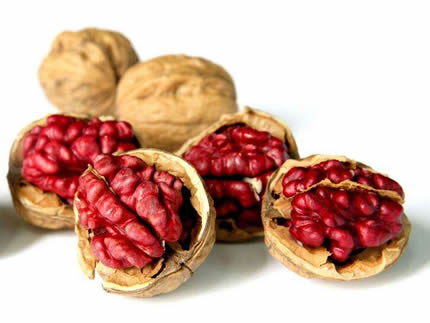Tel: 0086 21 5603 2171
Fax: 0086 21 3325 0914
Email: sales@walnutshellpowder.com
Red Walnuts
RED WALNUTS INTRODUCTION
Shengda Red Walnut leafing date is close to Chandler, occurring around mid-April. The harvest date of Red Walnuts is around the fourth week of September in China. It has a lateral fruiting habit with a medium to high yield. Nut is medium to small and round with a good shell seal. Different from all English walnuts, Shengda Red Walnut is a one-of-a-kind nut with appeal for specialty market for its deep red skin and rich, buttery flavor. Nutritionally, it stands side by side with the English walnut as a healthful option for both snacking and cooking, while offering a striking presentation. From our family to your families table, we trust you will discover unlimited ways to enjoy the great taste of our Red Walnuts.
Red walnut color varies from a bright red to a darker red, even reddish purple, depending on the variety and origin. The cultivars commercialized in the US and China are usually a vivid cherry red color. But some European red walnuts in the wild come in various red to purple shades, with color not being consistent from tree to tree. Only the thin skin covering the kernels is red; the kernels themselves are cream colored, just like those of the common walnut. The shells are a dull tan color and the walnut is larger.
As for taste, red walnuts have a slightly sweeter taste than brown ones, with a creamy texture with earthy flavor notes, but without the faint piquant aftertaste of brown varieties. Because red walnut trees are a novelty and relatively rare in the commercial setting, the kernels can be rather expensive and not as easy to find. Price varies from 20 dollars per pound to as much as 40 dollars per pound of kernels.
Since most of the good phenolic acids, tannins and flavonoids in a walnut is in the skin or pellicle, it¡¯s not hard to believe that the red walnut has some unique nutrients that aren¡¯t found in the English walnut.
RED WALNUTS NUTRITION
Red walnuts are high in vitamins B1, B2, B5, B6 and B9, iron, magnesium, phosphorus and zinc and boast an excellent manganese content. The variety also provides small amounts of vitamins B3 and E, calcium and potassium. They have a healthy carbohydrate profile: the moderate total carbohydrate, high fiber, low sugar and low net carbohydrate content make red walnuts good for diabetes and managing blood sugar levels when consumed in limited amounts.
Although high in fat, red walnuts are low in saturated fat and high in both polyunsaturated and mono-unsaturated fat. Red Walnut halves are an excellent source of omega-3 and omega-6 fatty acids and Omega-9, which act as natural anti-inflammatory agents, and help promote cardiac health. Saturated fat content is estimated to be like other common walnut varieties: under 8-10%. Also high in protein, the red walnut kernels are good for muscles and make an excellent brain food. Lastly, 100g of raw kernels provide an estimated of 650 kcal (kilocalories). As for the red color of the kernel skins, it¡¯s indicative of pigmented antioxidants of the anthocyanin family such as delphinidin and cyanidin compounds.
Given their nutritional profile, red walnuts provide benefits such as weight management, blood sugar control, benefits for skin appearance as a result of fatty acids and vitamin E, benefits for muscles as a result of protein content, energy and tonic action thanks to iron and B vitamins. Eating a few kernels helps curb hunger and cravings, nourishes the brain, supports nervous system activity, especially intellectual effort and provides benefits for bones, immunity, blood pressure and general cardiovascular health. According to the walnut entry on World¡¯s Healthiest Foods, Walnuts are a great source of gamma-tocopherol, a rather rare form of Vitamin E that has been shown to have very positive role in reducing heart disease risk.
FAQ ABOUT RED WALNUTS
1) What are red walnuts called?
In the US, they are simply called red walnuts. Just know they are the same species as regular brown walnuts, essentially a common walnut.
2) What are purple walnuts called?
In some parts of Europe, there are naturally occurring varieties with dark red to purple skin which are called blood walnuts because of their darker color.
3) Are red walnuts GMO (genetically modified)?
No, they are not. Red walnuts first occurred in the wild as a result of a natural mutation. Researchers simply graft trees with red-skinned walnuts and regular brown-skinned walnuts to produce a commercial variety with consistent traits (color, taste, texture, shell thickness etc.) that could guarantee stable characteristics over time.






